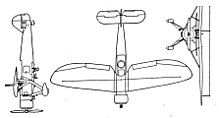Henschel Hs 122
| Henschel Hs 122 | |
|---|---|
 Henschel Hs 122 V3 |
|
| Type: | Close reconnaissance aircraft |
| Design country: | |
| Manufacturer: | |
| First flight: |
October 30, 1934 |
| Commissioning: |
1936 |
| Number of pieces: |
19th |
The Henschel Hs 122 was a close-up reconnaissance aircraft from Henschel Flugzeug-Werke .
Origin and development
The equipment of the air force included a close-up reconnaissance aircraft for the army. The plans to replace the biplanes planned by the Reichswehr in 1932 led to new orders in 1933. The RLM's aircraft development program envisaged a pilot series of 7 aircraft from Ernst Heinkel Flugzeugwerke and 16 from Henschel Flugzeugwerke, along with three test aircraft each. The development of the Heinkel He 48 was discontinued in the summer of 1935 and Henschel received the series order for the Hs 122. Since August 9, 1933, the project was worked on in Johannisthal, and the dummy was inspected on October 7, 1933 and February 20, 1934 .
| Test aircraft | V1 | V2 | V3 |
|---|---|---|---|
| Work no. | 4th | 5 | 6th |
| Start of construction | January 6, 1934 | March 15, 1934 | |
| start of building | May 15, 1934 | May 21, 1934 | |
| First flight | October 30, 1934 | January 11, 1935 | March 26, 1935 |
| Mark | D-UQEV | D-UBYN | D-UDIZ |
While V1 and V3 received the SAM 322 J engine, V2 was provided as a preliminary study for the installation of a German engine with water cooling and equipped with one of the British Rolls-Royce Kestrel , which the RLM bought in large numbers . The V3 was originally built as a training aircraft with dual controls.
The three test aircraft completed extensive flight and test programs in Schönefeld and in the E -stelle Rechlin, including. with D-UDIZ, the model aircraft for the series, also the weapons testing. In the first test phase of the V1 after the flight after the flight, the E-Agency caused the change to a so-called thin wing, which was also introduced in series, due to complaints about poor visibility.
Series A-0: On May 5, 1935, construction of the 16-piece pilot series began in Johannisthal and was delivered by August 1936. A planned increase to 27 aircraft with the A-1 series was omitted because the successor Hs 126 had already been ordered. The Hs 122 served various tasks in units and flight schools, also in the E -stelle Travemünde. In 1936 the robust high-decker with complete installation of special equipment (SO 1 (rigid attack armament), SO 2 (mobile defense armament) and SO 3 (drop and bomb equipment), plus on-board station B 1 (radio station) and hand-held camera HK 19 (photo equipment)) was launched in the Offered abroad. Delegations from Iraq and Austria expressed interest, no export took place.
construction
- Fuselage: oval light metal shell fuselage, front part of the fuselage is easy to maintain thanks to large, removable cladding panels
- Chassis: without a continuous axle, made up of two independent halves with suspension in the fuselage. Rotatable tail wheel
- Tail unit: Horizontal stabilizer stripped, vertical stabilizer self-supporting, light metal with sheet metal planking, rudder fabric-covered, rudder aerodynamically and statically balanced, adjustable trim rudder for elevator and rudder, fixed position of the fin by 3 ° to the left to compensate for the propeller torque
- Structure: two-part metal wing, two-spar, metal planking with the exception of the fabric covering the underside between spars, the ailerons and landing flaps
- Powerplant: Siemens SAM 22B air-cooled radial engine, 660 HP, NACA bonnet, with an exhaust manifold at the front.
- Equipment: as a close-up reconnaissance device, serial imaging device, FT device, handheld camera
Technical specifications
| Parameter | Data (Hs 122 V2) |
|---|---|
| crew | 1 pilot + 1 observer |
| length | 10.25 m |
| span | 14.50 m |
| height | 3.80 m |
| Wing area | 34.70 m² |
| Wing extension | 6.05 |
| Empty mass | 1650 kg |
| Payload | 860 kg |
| Max. Takeoff mass | 2530 kg |
| Wing loading | 92.90 kg / m² |
| Power load | 4.22 kg / hp |
| Engine | an air-cooled radial engine Siemens SAM 22B |
| power | 660 hp (485 kW) |
| Top speed | 270 km / h |
| Marching speed | 235 km / h |
| Landing speed | 88 km / h |
| Rise time | 18 min at 4000 m altitude |
| Service ceiling | 5600 m |
| Flight duration | 2.6 h |
| Armament | 1 × fixed machine gun for pilot 1 × rotating machine gun for observer Magazine for ten 10 kg bombs. |
See also
literature
- Horst Materna: The history of the Henschel aircraft works A. G. in Schönefeld near Berlin 1933-1944 . Rockstuhl, Bad Langensalza 2010, ISBN 978-3-86777-049-1 .
Web links
Individual evidence
- ^ With significant use of monthly reports and other documents from Henschel Flugzeug-Werke
- ^ Aircraft development programs in 1935
- ↑ Aircraft data : list of Henschel test aircraft, HFW documentation
- ↑ Rechlin test report no. 1139 functional test SO 1-17
- ↑ File note Technical Office LC II from March 27, 1935
- ↑ Offer Henschel aircraft Hs 122
- ↑ Helmut Schneider aircraft type book 1939/40
